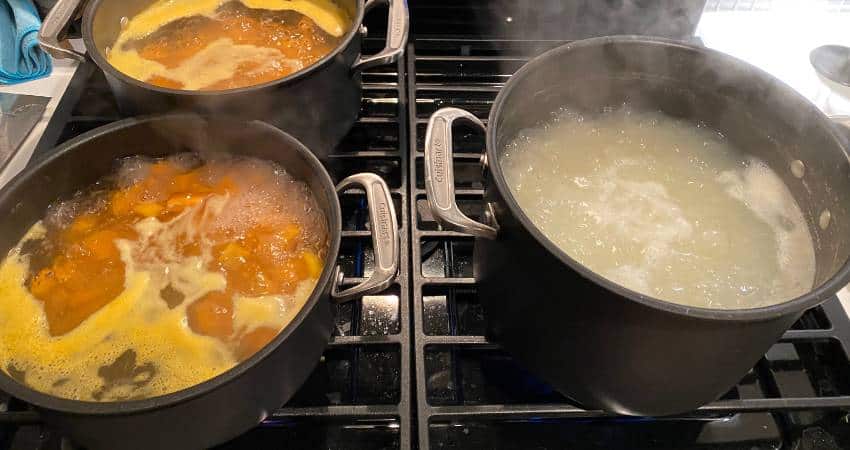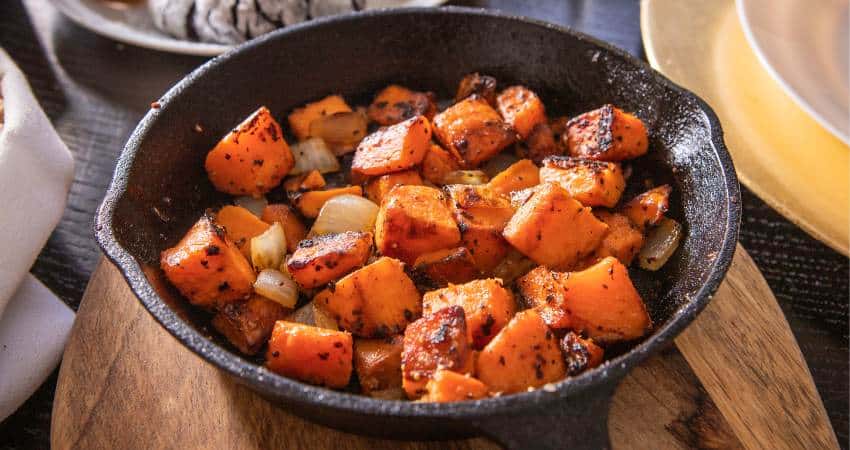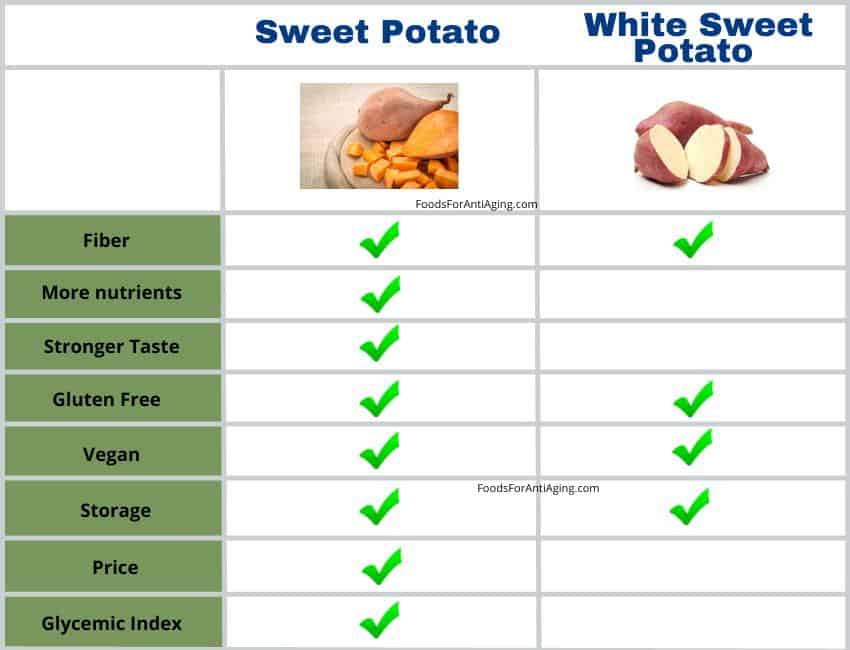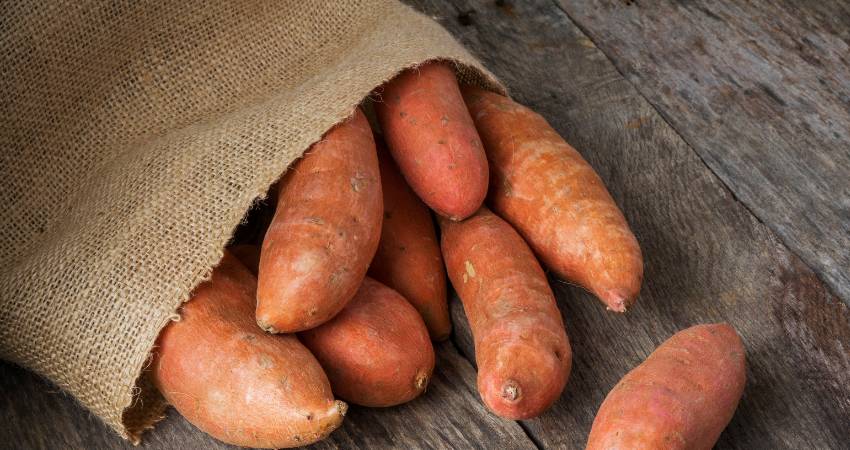White Sweet Potato vs. Sweet Potato: What’s The Difference?
There are many varieties of sweet potato including a white sweet potato. Therefore, let’s answer the question, what’s the difference between a white sweet potato and sweet potato?
The main difference is a white sweet potato has a white color flesh, and a sweet potato has an orange flesh. A white sweet potato has a pale copper color skin while an orange sweet potato skin is more rose to reddish. Regular sweet potatoes have a stronger flavor and contain more antioxidants.
This article will examine both potatoes in every detail including a side-by-side nutrient and antioxidant comparison. In addition, I’ll take a look at the difference in their taste, texture, price and if they can be substituted for each other.
Differences Between a White Sweet Potato and a Sweet Potato
During my health coaching sessions I get asked about the topic of potatoes often. I’ve purchased, researched and consumed both potatoes prior to, during and after writing this article. Let’s examine the differences.
- An orange or regular sweet has a redder, harder skin.
- A white sweet potato has a lighter color flesh, milder flavor and costs more..
- Sweet potatoes have a better glycemic index and contain more antioxidants.

Nutrition Potato Differences
Here’s a table of the nutritional contents of a 100-gram (3.5 ounces) serving of each potato.
| Sweet Potato Cooked (100 g) | White Sweet Potato Cooked (100 g) | |
| Calories | 90 | 90 |
| Protein | 2.01 g | 1.75 g |
| Carbohydrates | 20.7 g | 21.0 g |
| Fiber | 3.3 g | 3.5 g |
| Fat | 0.15 g | 0.0 g |
| Sugar | 6.48 g | 6.14 g |
| Vitamin A | 19,200 IU | 19,200 IU |
| Vitamin C | 19.6 mg | 19.5 mg |
| Iron | 0.69 mg | 0.63 mg |
| Calcium | 38 mg | 35 mg |
Nutrient Resources1 ((USDA: Sweet potato, cooked, baked in skin, flesh, without salt))
Sweet potato vs white, let’s compare the macros. Sweet is slightly more protein in a white potato. Both are similar in a calories and carbohydrates. White potatoes provide more potassium.
White Sweet Potato vs Sweet Potato: Antioxidants
| Antioxidant | White Sweet Potato | Sweet Potato |
| Carotenoid | 0.006 | 0.047 |
| Anthocyanin | 0.012 | 0.016 |
| Flavonoid | 0.617 | 0.705 |
| Phenolic | 1.580 | 1.490 |
At first glance the nutrients between the two are similar. This leads many people to wonder which one is healthier.
Sweet potatoes are healthier than white sweet potatoes due to their greater percentage of antioxidants. They provide more carotenoids, anthocyanins and flavonoids than white sweet potatoes.
The bigger difference between the two potatoes is the carotenoid antioxidants shown above2. Since the orange flesh sweet potato contains more carotenoids than the white, let’s discuss them in more detail.
Carotenoids are yellow and orange pigments which are a source of vitamin A. It’s what gives the regular variety its orange color.
Common carotenoids include:
- Beta carotenes
- Lycopene
- Zeaxanthin
- Lutein
Carotenoids are beneficial to eye health and the immune system. Let’s examine more of the health benefits of the two potatoes.
I often choose orange sweet over white potatoes due to their nutrients. Of all the potatoes, I prefer them for this reason.
Nutrition potato differences and more is explained in the following video.
Health Benefits
Eye Health
There are two nutrients the body converts into vitamin A. Most notably, Beta Carotene, which is easily absorbed by the body. According to numerous studies, vitamin A helps the eyes when it comes to dim light vision and dry eyes ((National Center for Biotechnology Information: Nutrients for the aging eye)).
Consuming one orange sweet provides 730% of the daily value for vitamin A. The Anthocyanins found in both potatoes have been found in studies to protect eye cells from damage improving overall eye health3.
Immune System
According to an article by Harvard University, vitamin A is a great source to stimulate healthy white blood cells4. These cells have the responsibility of keeping the immune system as healthy as possible to fight viruses and illnesses effectively.
Other nutrients like vitamin c and the antioxidant anthocyanin possess anti-inflammatory properties protecting against disease and illness.
Diabetes and Blood Sugar
Orange sweet have a good number of carbs which would lead one to think it can spike blood sugar a good amount. Although the carbs are complex and raise blood sugar more slowly. They have a moderate glycemic index and are considered safe for people with diabetes.
In a study involving 61 people with type 2 diabetes, they were given white sweet potato extract daily for twelve weeks. The researchers found fasting blood sugar levels decreased significantly. In addition, the participants lost body weight and lowered cholesterol5.
In another study, 18 men with type 2 diabetes were given white sweet potato extract. The results indicated the participants increased insulin sensitivity compared to those who received a lower amount of extract6.
I conducted my own research about the Glycemic index and here’s what The University of Sydney contained about both foods in their Glycemic Index Research and GI News website7.
Glycemic Index
The Glycemic Index (GI) is a scale measuring how fast a particular food raises or spikes the blood sugar in the blood8. Blood sugar spikes can lead to health complications with the heart, kidneys, eyes and nerves9.
In general, many people should try avoiding eating high-GI foods. Foods on the GI scale are categorized as:
- Low-GI foods: 55 or under
- Medium-GI foods: 56-69
- High-GI foods: 70 or over
How blood sugars levels are affected:
- Foods with a glycemic index 70 or more cause a quicker spike in blood sugar levels.
- Foods with a glycemic index 56 to 69 cause a moderate spike in blood sugar levels.
- Foods with a glycemic index 55 or less cause a slow spike in blood sugar levels.
Now we know what GI is, and how it affects blood sugar, let’s take a close look at the scores of each potato.
Sweet potatoes have a lower GI than white sweet potatoes. A boiled regular sweet has a GI of 44, and a boiled white sweet potato has a GI of 75.

Digestion and Gut Health
Both potatoes contain soluble and insoluble fiber. Dietary fiber remains in the digestive tract and provides gut related health benefits. Fiber rich diets have been linked to regular bowel movements and a lower risk of colon cancer10.
Potassium
Potassium helps the body get rid of excess sodium reducing fluid build-up. These helps keep systolic and diastolic blood pressure lower11.
According to Harvard Health, a number of studies have shown a connection between low potassium levels and high blood pressure12.
The more potassium, the more sodium your body will lose. Consuming too much sodium or not enough potassium throws off the delicate balance the kidneys need to remove the excess water13.
If you’re interested about how they held up against pumpkin for health and nutrition, check out my article.
Taste and Texture
Because they look similar from the outside, you would immediately expect the two vegetables to taste the same. However, once you peel the skin from both, you are greeted with two completely different-looking potatoes. To avoid confusion, let’s discuss the taste and texture of both.
- Sweet potato generally holds its sweet flavors consistently. You will almost always get a subtle starchy undertone with rich sweet flavors. The texture is stringy, crumbly, and soft. You can mash it for a smooth, fluffy texture. The skin is harder.
- White sweet potato has similar characteristics, however, the sweetness is more subtle. Although, you’ll still get starchy undertones. The texture is also similar except the white variety tend to be a little drier like a regular potato. The skin is softer.
I wanted to get the opinion of real people like you by conducting some original research. Therefore, I reached out to some clients, members of food groups and readers. I asked, which potato tastes better?
- 53% said they preferred the taste of regular potatoes sweet.
- 39% said they preferred the taste of white potato.
- 8% said they had no preference.
I also participated in my own blind taste test. We mashed them and seasoned them exactly the same. I chose the regular ones for their taste.
In the taste poll and my own taste test, regular sweet were found to taste better and was the winner.
It is not uncommon for people to buy one variant only to realize they got another type. Therefore, the next section discusses the possibilities of substituting one potato for the other.

Substitutions
You can substitute white sweet potatoes for sweet potatoes for almost any dish. They can both be baked, roasted, mashed or grilled. White sweet potatoes won’t taste as sweet, therefore when making a sweet recipe like a pie, extra seasonings may be used. Use equal amounts when substituting.
There are a few things you should consider before substituting these potatoes with each other.
If you are making sweet potato pie, the white lack the sweetness. Therefore, you may be changing a recipe slightly to make the dish a bit sweeter.
For fries, white sweet potatoes have the advantage. They are versatile, and you have more control of the resulting flavor because their overall taste is more subtle.
The following video explains the differences from the different sweet potatoes including the white potatoes.
The Cost of Potatoes
With the price of food increasing all the time, I’m sure the prices of each food matter to most people. Therefore, let’s examine the prices of both.
White sweet potatoes cost 52% more than per pound than regular sweet. White sweet potatoes average cost is $1.60 per pound and orange sweet potatoes cost $1.05 per pound.
To conduct my own research, I checked three different supermarkets located in my area. Both supermarkets are on different levels of pricing. Walmart is the most economical and Stop and Shop being more expensive.
Here are my findings, first I visited Walmart:
Walmart:
- Regular sweet
- $0.98 per pound
- White sweet potatoes
- $1.28 per pound
Shoprite:
- Regular sweet
- $0.99 per pound
- White sweet potatoes
- $1.92 per pound
Stop and Shop:
- Regular sweet
- $1.19 each

How To Store White Potato and Sweet
White and orange sweet potatoes are both stored in a cool, dry, ventilated container. They should be kept out of the refrigerator in a dark place away from heat. A humid basement or root cellar is the best area.
Keeping a potato in the refrigerator is not the best because it produces a hard center and an unpleasant taste. They both can store for about two weeks in the proper conditions, anywhere from 55°F to 60°F14.
Both potatoes can be stored together. Keep them in a ventilated container like a potato keeper or burlap bag.
When picking either potato, always choose ones large and firm looking. If you have a local farm or stand close by, buy them there. The ones in the supermarket probably have been stored for months already, while farm-fresh varieties may only be a week old.
Find out how purple yams compared in my article, Purple Sweet Potato vs Purple Yam: What’s The Difference?
If you have any questions to ask me about this article don’t hesitate to comment below or email us. You can find an email on our contact page.
Read Next – More Food Articles!
Sweet Potato vs. Butternut Squash: A Comparison
Purple Sweet Potato vs Sweet Potato: What’s The Difference?
Sweet Potato vs. Russet Potato: What’s The Difference?
Sweet Potato vs Yam Nutrition and Benefit Differences
- USDA: White Sweet Potatoes [↩]
- ScienceDirect: Comparative analysis of phytochemical and nutrient availability in two contrasting cultivars of sweet potato (Ipomoea balatas L.) [↩]
- National Center for Biotechnology Information: Review on nutritional composition of orange-fleshed sweet potato and its role in management of vitamin A deficiency [↩]
- Harvard Health: Vitamin A [↩]
- National Center for Biotechnology Information: Efficacy of Ipomoea balatas (Caiapo) on diabetes control in type 2 diabetic subjects treated with diet [↩]
- National Center for Biotechnology Information: Mode of action of ipomoea balatas (Caiapo) in type 2 diabetic patients [↩]
- The University of Sydney: Glycemic Index Researcher and GI News [↩]
- Harvard Health Publishing: Glycemic index for 60+ foods [↩]
- National Institute of Diabetes and Digestive and Kidney Diseases: Know Your Blood Sugar Numbers: Use Them to Manage Your Diabetes [↩]
- National Center for Biotechnology Information: Mechanisms linking dietary fiber, gut microbiota and colon cancer prevention [↩]
- American Heart Association: How Potassium Can Help Control High Blood Pressure [↩]
- Harvard Health: Potassium lowers blood pressure [↩]
- National Center for Biotechnology Information: The Effect of the Sodium to Potassium Ratio on Hypertension Prevalence: A Propensity Score Matching Approach [↩]
- North Carolina Sweet Potatoes: How To Store Sweet potatoes [↩]
